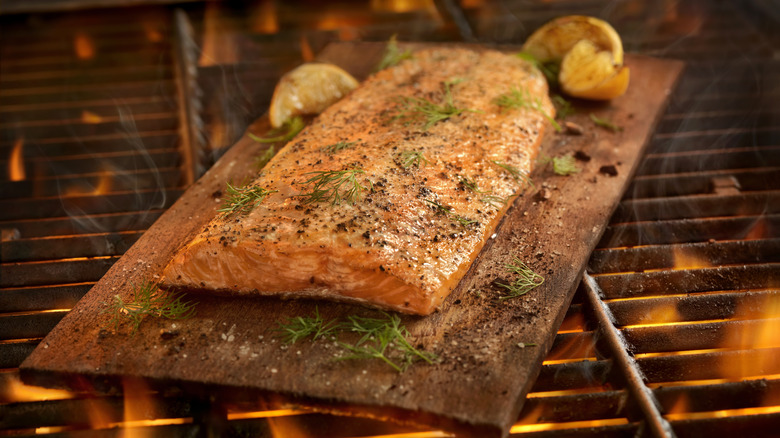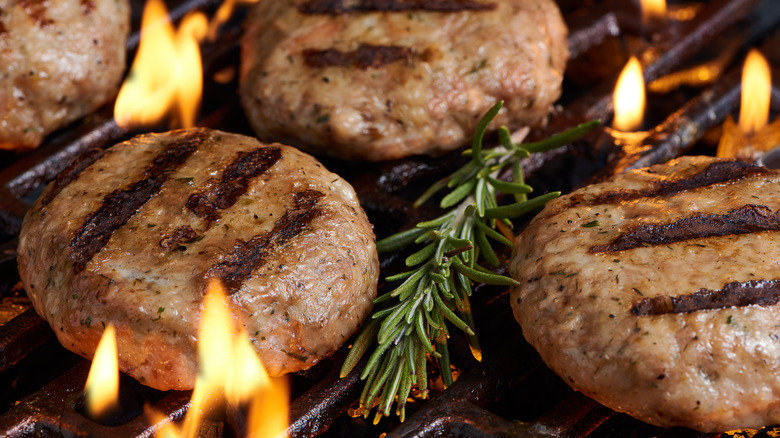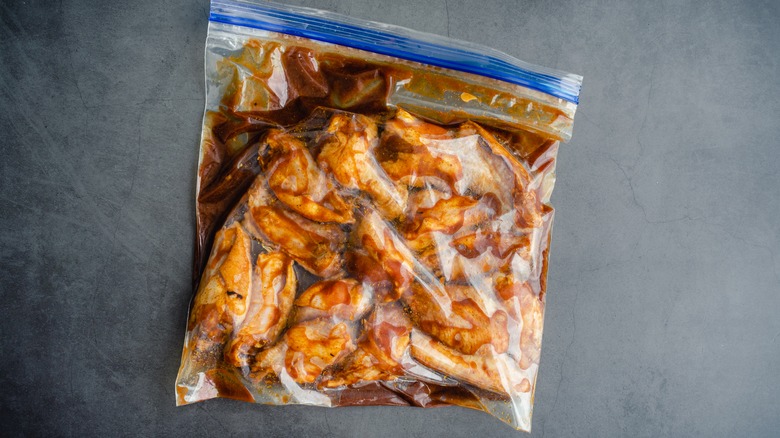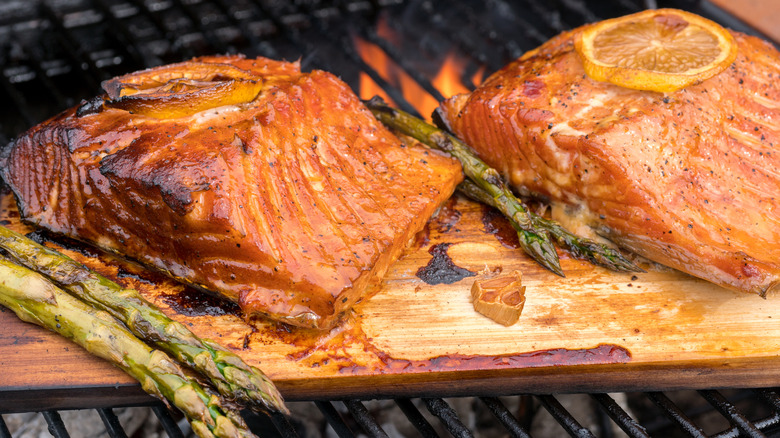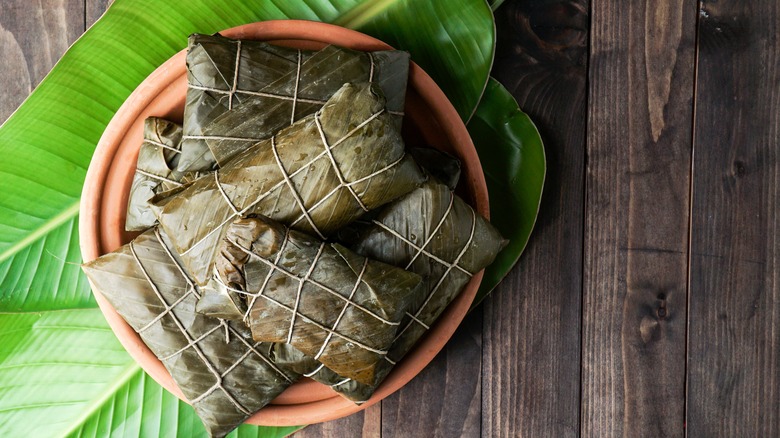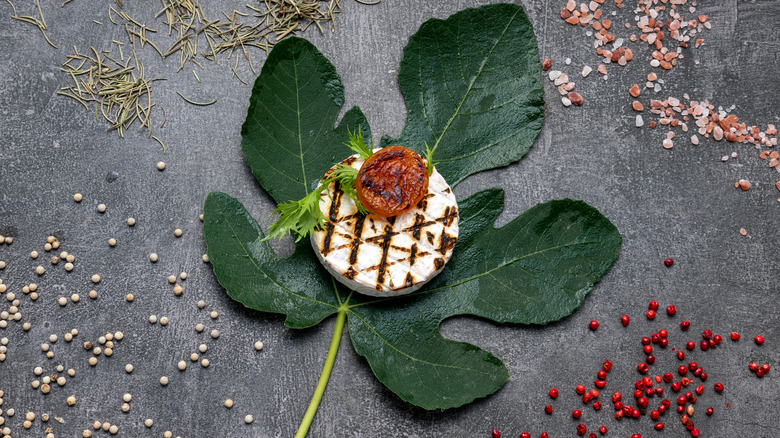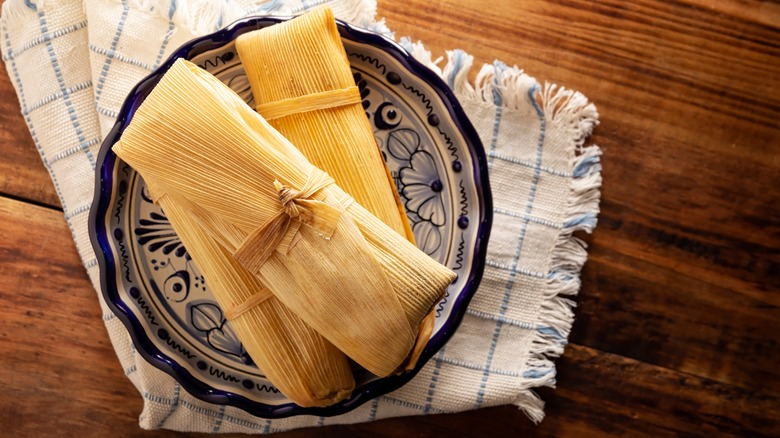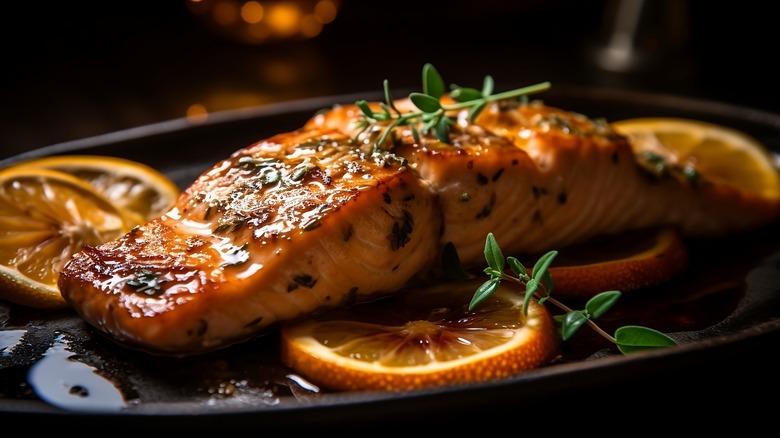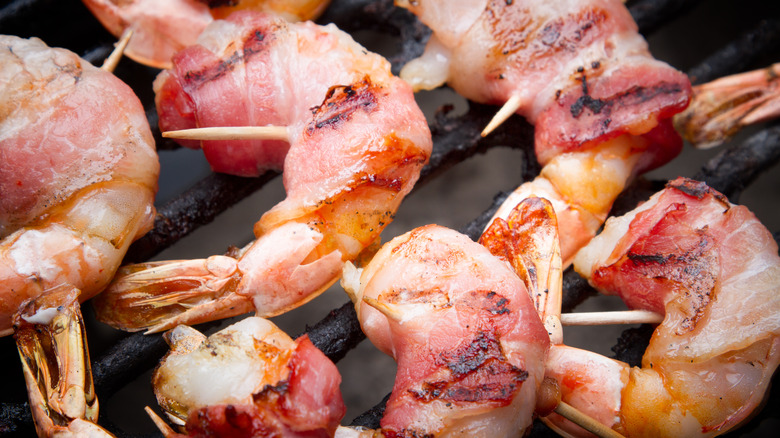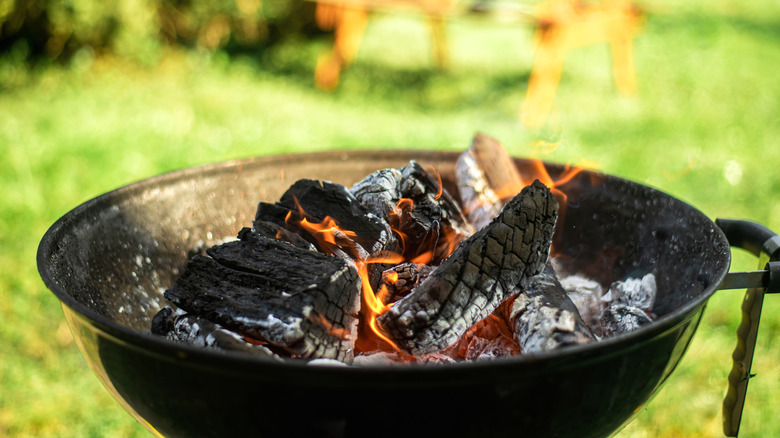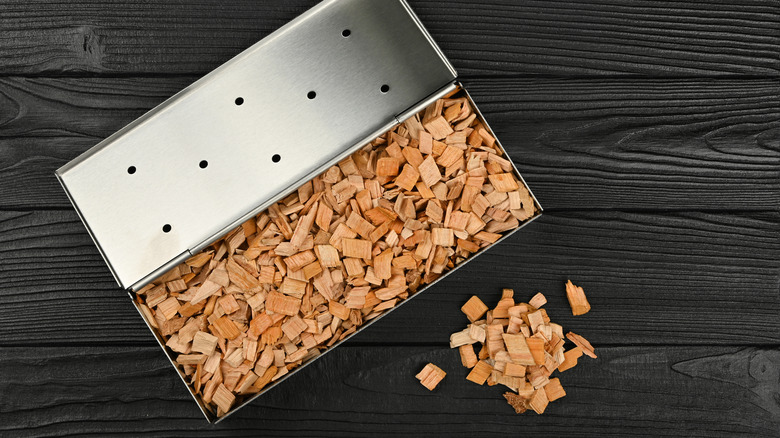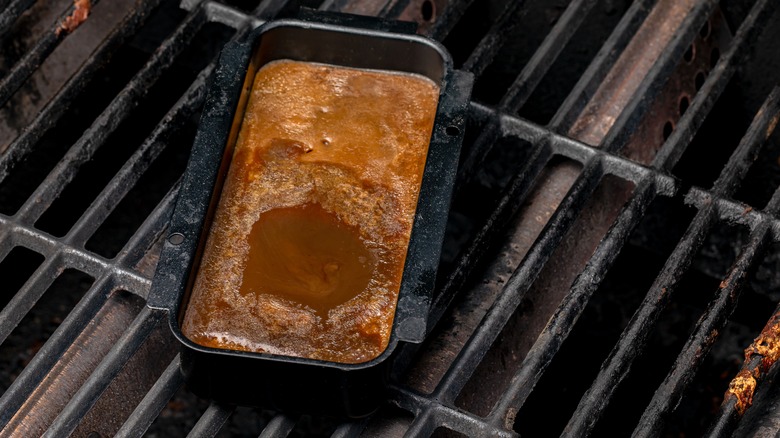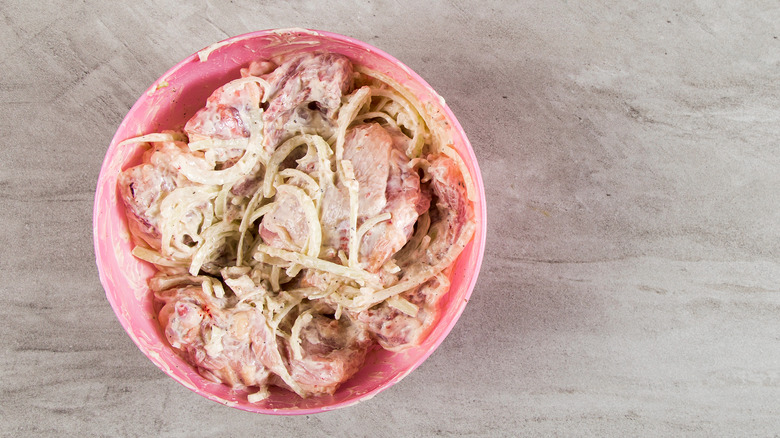12 Flavorful Additions For Next-Level Grilling
Grilling at a backyard cookout is the optimal way to flex your culinary skills in front of an audience. And nothing's more impressive than serving up a Michelin-star worthy masterpiece at a barbeque for family and friends.
But how do you level up your grilling game from basic meat-on-the-grill fare to something more refined? Whether you're a seasoned grill master or just starting to explore the world of outdoor cooking, the key to unforgettable barbecue truly lies in the details — like adding herbs straight to the grill or using soda to sweeten your meats.
From creative brines and aromatic infusions to techniques that have been around for thousands of years, we have the insider tips to transform your backyard gatherings into culinary experiences that will leave your guests raving. So if you're looking to up your grill game, check out these flavorful additions that will have everyone asking for your secret recipe.
Throw some rosemary on the grill
Rosemary is a versatile herb with a delicious pine-y aroma. It's also incredibly sturdy, which means it can be thrown straight on to the grill before adding your meats and veggies. The result is an infusion of herbaceous, smoky flavor that adds serious depth to your barbecue.
When it comes to adding herbs directly to your grill, you aren't restricted to just rosemary. Any type of "hard" herb will do, which is a way to classify herbs that are considered to be more durable. Other herbs that will stand up to the grill no problem are thyme, sage, and savory. These pungent herbs taste good with pretty much any kind of meat, but pairs especially well with gamey meats like lamb.
If you really want to wow your guests with your culinary expertise, replace wood or metal skewers with a hard herb for a unique and tasty twist on the standard kabob. Yes, you can actually use the herb stem as the skewer! This unique spectacle not only looks cool, but it will give your meats and veggies an herby infusion that's super tasty.
Use a soda-based brine or marinade before grilling meats
Coca-Cola has other uses besides being the star beverage at your cookout. When used in a brine or marinade recipe, the acidity from the soda can break down the muscles in the meat to make it fall-off-the-bone tender. Then, when the sugars from the soda meet the heat from the grill, a caramelization takes place that adds a touch of sweetness to your barbecue.
For an easy cola-based marinade, mix Coca-Cola, soy sauce, garlic, brown sugar, lemon juice and Worcestershire sauce. Let your meat soak in the solution overnight and pat dry before grilling.
If Coca-Cola isn't exactly your thing, don't worry — you can use pretty much any other type of soda as long as there's citric or phosphoric acid. These key ingredients are in sodas like Root Beer, Dr. Pepper and Sprite, and help tenderize the meat. A word of warning: Be sure to cook your meat no more than eight hours after it leaves the marinade so your meat stays intact.
Cedar planks add a smoky flavor
Cooking food on cedar planks is an ancient technique that adds a delicious smoky flavor from the wood. Seafood pairs perfectly with cedar-like flavors, so you might want to seriously consider this technique if fish is on the menu. Though, you can enjoy the tasty benefits of using cedar planks when cooking any type of meat or vegetable.
What's great about this grilling technique is that it helps retain moisture (you'll soak the plank for one or more hours before grilling) better than if you threw your food directly on the grill. And since you really don't need to add oil to your cedar plank, it's also considered to be a healthier way to cook food.
Grilling with cedar planks is simple — you lay the meat on the block of wood, which is placed directly on the grill. For an extra punch of flavor, place a layer of fresh herbs, like bay leaves or rosemary, between the wood and your meat or veggies.
Grill your fish on banana leaves
Another grilling addition that will impress your guests is using banana leaves as a barrier for your food. This method works best with fish or vegetables and is popular in Vietnamese cuisine — and with good reason. Banana leaves on the grill infuse a smoky, earthy flavor (reminiscent of tea or licorice) into your food. The flavor infusion is so subtle, though, that it complements the food rather than overpowers it.
There are other benefits to cooking with banana leaves. It does an impeccable job of retaining moisture, which is essential to prevent delicate fish from drying out over a hot grill. It also acts as a mat to keep small vegetables or fish pieces from falling through or sticking to the grates.
Banana leaves can be used as serving plates to really charm your guests — make sure to wipe down the leaves thoroughly before working with them.
Fig leaves are another tasty way to wrap your food
A bit more uncommon is grilling with fig leaves, which infuse a nutty, almost vanilla flavor into your meal. If you're serving up Greek food, this culinary technique is a must-try since fig leaves pair so well with Mediterranean flavors. And like the banana leaves, fig leaves will keep food moist and intact when up against a fire-hot grill. This is especially important when dealing with delicate food like fish.
When grilling up fish in fig leaves, make sure the body is fully wrapped (leave the head and tail exposed), using twine to tie the bundle together. (Soak the twine in water so it doesn't burn on the grill.) Your fish is done once it reaches 145 degrees Fahrenheit.
Another good use for fig leaves is wrapping it around ground meatballs before throwing it on the grill. Fig leaves pair nicely with lamb, so consider making kabobs at your next cookout. Just cover the ground lamb meatballs in fig leaves before placing them on the grill. Serve with tzatziki for an aromatic Greek inspired dish.
Grilling with husks on makes corn tender and juicy
Do you grill your corn husks-on or husks-off? If you keep those husks on, you know exactly how delicious the outcome is. Think of steamy, perfectly tender kernels that are juicier than you can imagine. While grilling the corn directly on the grill does have some benefits, like caramelization, it exposes the kernels to serious heat that can dry them out (or worse, burn them) if you're not careful.
Beyond corn, you can cook pretty much any meat or vegetable in corn husks. This cooks your food in a gentle steam that enhances the natural juices — no foil necessary. A recipe well-known for using the corn husk for grilling is the beloved tamale. The tamale is a popular dish in Latin America and is a masa dough with a meat and vegetable filling. It's grilled and served in corn husks, which adds a smoky sweetness to the dish.
To grill proteins, vegetables or tamales in corn husks, soak the husks in water for a few minutes before using. This helps make them flexible and easier to work with.
Prevent sticking on the grill with lemon slices
Grilling with fish can be tricky. The main reason being that seafood tends to stick to the grill, causing the entire filet to fall apart. So how can you get that grilled effect without ruining the meal? Enter lemon slice.
Citrus fruits like lemons, limes and oranges can act as a barrier between the food while grilling, which comes with benefits. It gets your fish as close to the grates as possible, allowing it to absorb all the smoky goodness from the grill. And due to the natural oils found in the peels, citrus won't stick to the grates, so you'll have no problem flipping your fish midway through cooking.
Even better: Citrus pairs beautifully with fish. After sitting on the grill, it develops a sweet char and can then be served on the side to your guests to squeeze on their meal.
Use bacon to wrap your meat for a burst of flavor
Bacon can make everything better, especially when it comes to grilling. The smoky pork fat that renders out the meat during cooking infuses your food with bacon goodness that will really amplify your meal. And that's not all it does. The fatty grease actually insulates your protein, which helps retain moisture to keep your meat from drying out.
You don't need to stop at just meat or seafood, either. Bacon wrapped vegetables are definitely a crowd pleaser. And you really can't go wrong with bacon-wrapped jalapeños with cream cheese stuffed inside.
To cook meat, fish or vegetables in bacon on the grill, wrap a piece of raw bacon around the piece of food you want to cook. If needed, you can secure your bundle with a toothpick. Keep in mind that the high fat content in the bacon can cause it to burn easily. So when cooking, avoid putting your bacon wrapped goodies too close to the flame and be sure to keep an eye on everything.
Use wood in your charcoal grill
Grilling with charcoal definitely has its advantages. Charcoal heats up quickly, it creates an even cook, and it's easy to light and keep lit. Plus, it's affordable and you can buy it pretty much everywhere. But when you're only using charcoal, you're truly missing out on the depth of flavor that grilling with wood provides. From mesquite and hickory wood to oak and apple wood, there are several types of woods to choose — and each impart a unique flavor to your food.
If you want the convenience of the charcoal but the gourmet taste from the wood, consider mixing the two at your next cookout. Together, charcoal and wood make a dream team and will even add layers of depth to your food that can't be achieved alone. This method will also cook your food faster than if you only used wood, which can take a while to heat up.
To add wood to your charcoal, place a piece of wood to the side. Small logs of wood are ideal since they'll burn slower than wood chips.
Wood chip boxes add smoky flavor to gas grilled food
Gas grilled food will lack the smoky flavor that comes from using charcoal and wood. So if you're working with just a gas grill, you'll miss out on some of that extra flavor. But don't fret, you can make up for that with a wood chip box.
Wood chip boxes hold burning wood chips while they emit a fragrant smoke onto the food, infusing your grilled food with a smoky taste. They're typically made of either stainless steel or cast iron to handle the high heat and have holes in the lid so smoke can escape. Just put your wood chip box directly on the grill, add in your favorite store-bought seasoned wood chips and light them up.
Before purchasing a wood chip box, make sure that it'll actually fit in your grill since they come in different sizes. If you're in a pinch, you can make an aluminum foil container for your wood chips to protect them from the heat.
Use a pan to utilize drippings in a tasty dipping sauce
A drip pan is a great tool to use while grilling because it's multi-purposeful. For one, it stops grease from dripping onto an open flame, which prevents flare-ups. It can also help keep your grill nice and clean. The best part about these pans, though, is that you can use those delicious drippings to baste your meat or as the secret ingredient to a savory sauce. Drippings taste especially good in a homemade barbecue sauce and will really impress your guests. For a less fatty version, let the drippings cool in the fridge and skim off the fat that culminates at the top.
You can purchase a drip pan online, or you can DIY a pan out of aluminum foil. Keep in mind this method only works with grills that have two tiers of grates, so you can place your tray directly underneath the food without exposing it to the open flame.
Coat your meat in mayonnaise before grilling
Love it or hate it, mayonnaise can really level-up your grilling. The high fat content in mayo helps keep your meat juicy and tender and will leave the most beautiful crispy brown skin on the outside. This is especially helpful for thin cuts of meat that will typically overcook before browning.
But if you're a bona fide mayo-hater (because, you know, some people are) rest assured that you'll detect no mayo flavor left behind after grilling. Since mayo is mostly fat, it enhances the flavor of the meat rather than adding to it. Think of it more like a functional tool rather than a flavorful addition.
Still, you don't need to settle for plain ol' mayonnaise. What's great about this ingredient is that it's so versatile. You can add other components into the marinade, like vinegar for acidity or jalapeños for spice, which layers in flavor for a more complex taste. You can even mix in other tasty sauces, like barbecue sauce or pesto — the opportunities are endless. To grill with your mayo-based marinade, just cover your meat in the white stuff before grilling, and you'll be good to go. By using any one of these techniques, you'll add a dash of culinary magic to your food that is sure to make a lasting impression on your guests.

